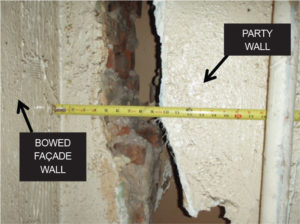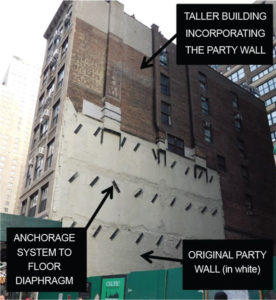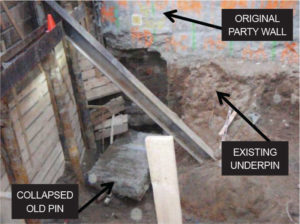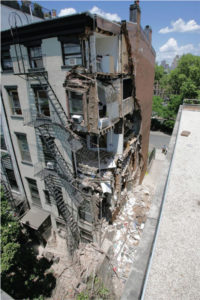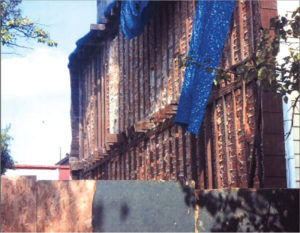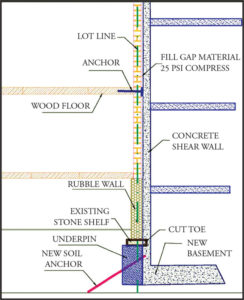Party walls are frequently used in low-rise developments due to their capacity to provide economical structural support in denser areas. They were more prevalent and taller in earlier times when American cities developed. One can find many old party walls in cities along the Atlantic seaboard – from Portland, Maine, to Charleston, South Carolina. In the older areas of New York City, there are over 15,000 existing brick masonry party walls, many in four- or five-story buildings. The shared use by adjoining owners resulted in real property law developments which have added constraints that FEMA 547 Techniques for the Seismic Rehabilitation of Existing Buildings considers overriding. FEMA 547 justifies its lack of guidance: “For conditions along property lines or involving party walls, the two buildings likely have different ownership, and practical and legal issues may be more significant than technical ones.” This article introduces the reader to historical party walls and presents construction and engineering challenges encountered on construction sites that border old masonry party walls. New York City Building Code (NYCBC) regulations are discussed, but nothing in this article should be interpreted as real property law advice.
A Short History of Regulations
We know from the Roman engineer, Vitruvius, in his famous treaty De Architectura, that party walls already existed in Rome around 30 B.C. They were used as bearing walls set along property lines to support floors of adjoining structures. Roman legal statutes from that period established the rights and obligations of owners of party walls. The first regulation involving party walls as fire barriers was issued in the aftermath of the Great Fire of London (1666). To combat the “mischief of fire,” laws were promulgated requiring the use of masonry in perimeter walls, including party walls. Thus, the structural bearing function became intertwined with the fire containment function.
Party wall legal theories that developed separately in the different states in colonial America are the source of differences from state to state in legal practices that exist today. In 1791, George Washington promulgated a party wall regulation for the District of Columbia. The wood frame construction of the original New York City (NYC) buildings allowed several major fire conflagrations to occur. As a consequence, use of brick or stone in perimeter walls was mandated by fire ordinances dating as far back as 1830. By 1900, row houses using party walls covered block after block. Even when building heights had reached six or seven stories, as long as the construction occurred on narrow lots, masonry party walls remained the choice of builders.
Since the 1870s, successive NYC building regulations have included specific instructions for party walls. There were 20 entries in the 1901 NYCBC that were mostly prescriptions for the construction of party walls. Around the turn of the 20th century, fire science had developed as a separate field, and the 1905 National Building Code developed by the National Board of Fire Underwriters (NBFU) and the American Insurance Association had 9 entries similar to those in the 1901 NYCBC. Up to the 1916 NYCBC, the mandated party wall thickness was the result of empirical structural considerations related to applied weight. Following the lead of the NBFU, the 1916 NYCBC introduced the concept that firewalls be specified according to mandated fire tests. Several technical developments led to the near elimination of specific party wall structural provisions in building codes, such as when the empirical design of masonry was replaced by an engineered design of masonry, and when steel and concrete frames replaced masonry as bearing systems for tall structures. The 2014 NYCBC uses the IBC definition: “Any wall located on a lot line between adjacent buildings, which is used or adapted for joint service between the two buildings, shall be constructed as a fire wall (sic).”
Although not always explicitly stated in codes, a party wall needs to meet both firewall and material specific structural design requirements; in the case of a fire in one building, the wall is expected to maintain its structural stability and stop the fire from spreading to the adjoining building.
The usual problems of demolition and excavation along buildings on lot lines are amplified when a party wall lies on that line. The structural function of the wall needs to be preserved. Also, weatherproofing needs to be added. Almost all of the references in the 2014 NYCBC are prescriptions for the protection of existing party walls during construction or demolition. Several other jurisdictions (Philadelphia, Washington D.C., and more) have similar regulations for the protection of party walls.
Existing Party Walls
Attached unreinforced masonry buildings sharing a party wall constitute a more stable unit than separated buildings. The larger footprint of the attached structure leads to much longer shear walls. In addition, whatever the direction of the out-of-plane load on the party wall, these loads can be transferred by compression to the floor diaphragms on the opposing side.
An incident involving an underpinning operation provided proof of the higher reliability of party walls. An improper construction procedure led to the partial collapse of a rubble foundation that was supporting a party wall separating two historic buildings. A bottom section of approximately 25 feet collapsed, leaving about 15 feet of rubble foundation standing at each end. The soil underlying this remaining foundation was competent and the three-story unreinforced masonry wall was able to turn into an arch spanning 25 feet above the collapsed area. Most independent walls would have failed, but the wood floors on both sides of this wall maintained its geometric stability and the restraint provided by the floors allowed the wall to sustain the significant increase in compressive stresses.
Many owners may not be aware of the obligation to maintain, in common, the structural as well as the fire separation functions of party walls. An interesting incident occurred in 2009 when the inspectors determined, while responding to a complaint about a facade bowing, that the facade was common to two attached buildings. The interior inspection revealed a 5-inch crack (Figure 1) that had developed along the line where the party wall used to be keyed into the facade. Each building was owned separately, and the owners could not reach an agreement to repair the crack. The fire separation was compromised and the collapse of the facade onto the street was imminent. As the engineers could not find a solution to arrest the evolution of the bowing, the facade was ordered demolished.
Locating Existing Party Walls
In addition to legal constraints, old party walls might constitute spatial constraints as their presence limits buildable area or influences the location of columns or shear walls. The “discovery” of a party wall in the construction phase results in complicated changes and significant delays. It is essential to recognize the presence of such walls at the preliminary stage of a project.
When one plans to develop a new building on a lot that is still occupied, an exterior topographical survey may not reliably determine the presence or even the exact thickness of a party wall. Even more, such a wall might not lie exactly centered on the property line. Rarely do original construction drawings exist, and current owners may be unaware and may only infer the presence of a party wall. Since the thickness of two abutting but independent walls can be larger than that of a party wall, a simple probe may be sufficient to elucidate the situation. In many cases, adjoining owners may not accept acquiring additional data, especially when the measurement requires destructive probes.
In older New York City neighborhoods, as a result of successive development on the same site, it is not uncommon to find party walls extending or incorporating older party walls (Figure 2). Depending on the shape of the original building, these remnant walls may not be continuous or may not span the entire length of the more recent wall, and may be missed by probes.
A serious accident that took place during the underpinning of the foundation of a fifteen-story loft in midtown Manhattan exemplifies the danger of not exploring the layered history of party walls adjoining a construction site. The steel frame loft had been erected around 1926 on a site previously occupied by a masonry building that belonged to a group of attached 1880s tenements. When originally constructed, the loft’s masonry incorporated the party wall of the attached remaining tenement building. Also, this 1880s wall was underpinned to accommodate the deeper basement of the loft. In 2014, the remaining tenement was demolished and excavation for a new building commenced. The basement of this new development ran even deeper than the loft’s basement, and an underpinning installation started. It appeared that the contractor was not fully aware that he was, in fact, undermining an older underpinning job. While he was digging, an old unattached pin overturned and collapsed with tragic consequences (Figure 3).
When the existence of a party wall is confirmed, the proper course of action is to obtain acceptance from the adjoining owner for any construction involving this wall. The acceptance of the proposed work is formalized in a legal document called the Party Wall Agreement. Recently, the NYCDOB issued a standardized form. Such agreement is necessary when owners of adjoining lots decide to build a lot line wall to be used in common. In many cases, older attached buildings were erected by the same developer and each building was subsequently sold to different individuals. Although no Party Wall Agreement was signed, the owners’ legal rights and obligations are implied by the mere existence of the wall and its common use.
Adjoining Demolition
Demolition along a party wall results in new structural conditions and exposure to potential adverse weather conditions. As a result, the party performing demolition is required to utilize a series of proactive measures.
Since 1968, the NYCBC required: “where the floor beams of the adjacent building bear on the party wall, the person causing the demolition shall ascertain that such beams are anchored into the wall and, where such anchorage is lacking, shall provide anchorage or otherwise brace the standing wall.” The validity of this requirement was confirmed by several recent wall collapse investigations that determined that these party walls were not anchored when the adjoining building was demolished (Figure 4). As explained in the Collapse of Masonry Structures under Non-Extreme Loads [Eschenasy, Second Applied Technology Council’s (ATC) & the Structural Engineering Institute’s (SEI) Conference on Improving the Seismic Performance of Existing Buildings and Other Structures], forensic investigations determined that the collapses were not due to over-stress but to loss of stability.
An engineering investigation is required before placing any special load on a party wall, for instance when the basement of a demolished building is filled with soil. Additional bracing of a wall may become necessary when the wall is not plumb or starts to lean following demolition or excavation.
Demolition adjoining “nogging” party walls poses special difficulties. The noggin (or nogging) wall is an assembly where the space between wood studs is filled with random bricks (Figure 5). Building regulations up to 1916 allowed this type of construction to be used as a building separation. Today, there are still a good number of such walls that exist. Vinyl siding has been, and still is today, the owners’ primary choice for weather proofing noggin walls. Investigations of several nogging wall collapses blamed significant rot of the studs resulting from rainwater that had penetrated behind the vinyl cladding. In contrast to regular wood stud walls where the air around the studs allows evaporation of the water, the bricks that are set tight against the studs preclude evaporation. Even worse, the deteriorating conditions are not usually observed in time due to the mask provided by the vinyl siding. In addition to improving weather proofing, a proper solution to stabilizing these noggin walls is to brace them with properly nailed wood boards.
Developing an Adjoining Structure
As long as masonry was the main structural bearing material, the vertical extension of party walls was permitted under the condition that the existing wall was lined with additional brick to meet the total required thickness for the new height. When, at the turn of the 20th century, masonry bearing walls for high-rise buildings were abandoned in favor of steel frames, engineers faced different challenges when working in the vicinity of masonry party walls.
As early as 1912, the Kidder Parker Handbook observed that “when buildings of skeleton construction are erected without a party wall agreement, it is usually impossible to obtain a symmetrical foundation directly under the columns supporting the side or party wall.” The Handbook recommended cantilever foundations. The 1915 National Building Code indicated: “Where an existing party wall is to be incorporated in a new building of skeleton or curtain wall construction, the vertical extension of the existing party wall shall be supported entirely by columns and girders.”
Many incidents and delays occur during excavations when the configuration of the party wall foundation is unknown. It is essential to use an exploratory pit to understand the shape of the existing footing. Typically, unreinforced masonry walls were supported by a continuous rubble stone wall that was approximately six inches wider than the wall above. Some weaker soils required this rubble wall be placed on an enlarged base – on a stepped masonry, stone, or concrete shelf – at least six inches wider than the wall above. Obviously, such enlargement encroaches on the intended location of the new foundation wall (Figure 6).
If the toe needs to be removed, this must be indicated in the Party Wall Agreement. Sawing off the toe needs to be preceded by an underpinning solution that prevents the tendency of the foundation to rotate as a result of the eccentric application of the wall’s gravity force resultant. In a recent case, where the underpinning and removal of the toe were not properly engineered, a substantial increase of the existing building’s lean occurred. It required extensive shoring.
Concerns about buildings “pounding against each other” during a seismic event have led to the introduction of “structural separation” requirements in engineering standards. Structural separation is not necessarily the opposite of party wall construction since, from a structural engineering point of view, a group of attached buildings forms a single structure.
Following the 1995 introduction of the building separation requirement in NYCBC, it was observed that when a new building was built, separated by the code required gap from an existing unreinforced bearing masonry structure, the latter could start to lean and close the gap. To prevent this lean, the code now requires the structural separation along unreinforced masonry structures to be filled with a material that has a minimum compressive strength of 25 psi.
Commonly, in new tall buildings, concrete shear walls are built along lot lines and function as firewalls and as an envelope enclosure. When adjoining existing party walls, these shear walls need to be placed further away from the lot line by a distance equal to the protruding wall dimension. Owners perceive this as a loss of rentable space.
Conclusions
In their millennial existence, party walls have saved material and have performed well. At the time of their erection, these walls saved space. However, today, when the same lots are used for redevelopment, the presence of party walls reduces the buildable area, especially at the basement level. The presence of such old party walls places additional obligations on the developer and increases the risk of foundation excavation accidents. When a project occurs in an area occupied by old masonry buildings, the presence of a party wall along a lot line needs to be probed as early as possible.
Given the ubiquity of attached masonry structures in older U.S. cities, it is surprising that recent standards and model codes that cover existing buildings, i.e. the International Existing Building Code (IEBC) and the American Society of Civil Engineers ASCE 41-13, Seismic Evaluation and Retrofit Rehabilitation of Existing Buildings, do not devote specific prescriptions for party walls. Hopefully, this will be addressed in the future.▪

